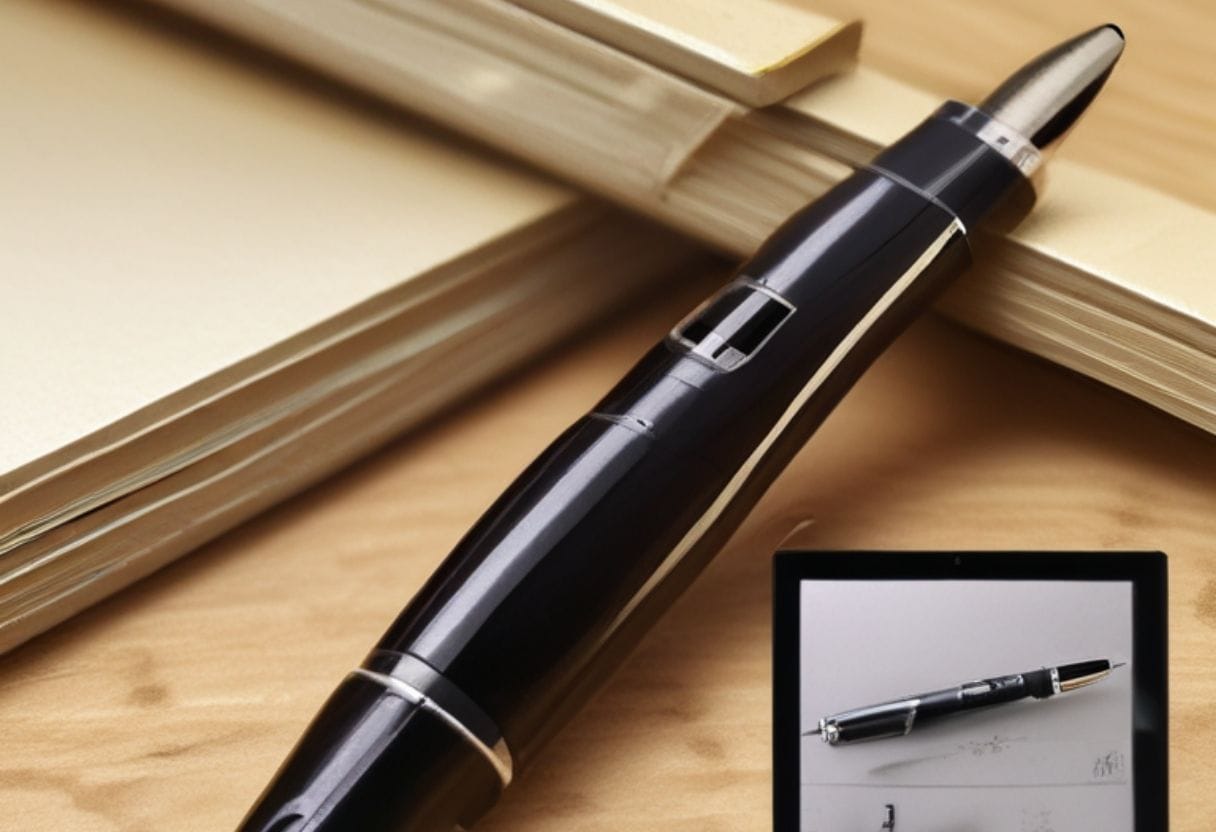Struggling with tangled tape and slow packaging processes?
An automatic tape dispenser is the game-changer your workspace needs. It streamlines operations and eliminates the hassle of manual cutting. Traditional tape application can be time-consuming and inefficient, leading to wasted materials and frustration.
With an automatic tape dispenser, you get precise, pre-measured tape lengths at the push of a button, reducing waste and boosting productivity. Advanced features like adjustable tape width settings (3mm to 60mm) and programmable cutting lengths ensure a seamless, customized solution for all your packaging needs.
We earn a commission if you purchase at no additional cost to you.
These machines serve multiple environments, from small office settings to large warehouses. You’ll find models with carousel designs for round tape rolls and others with straight-feed mechanisms, each offering unique advantages for specific applications.
Key Takeaways
- Automatic tape dispensers cut material costs by delivering precise tape measurements and reducing waste
- Modern dispensers accommodate various tape widths and lengths to suit different packaging needs
- Electric models increase efficiency by automating repetitive taping tasks in high-volume operations
Overview of Automatic Tape Dispensers
Automatic tape dispensers transform packaging and industrial processes through precise, motorized tape-cutting and dispensing technology. These devices minimize manual effort while maximizing accuracy and speed.
History and Evolution
The first automated tape dispensers emerged in the 1950s as basic mechanical units for industrial packaging lines. Early models featured simple length presets and manual feeding mechanisms.
The 1980s brought electronic controls and digital displays, enabling more precise measurements and multiple-length programming options. Modern dispensers now incorporate sensors, touchscreens, and advanced cutting mechanisms.
Today’s units offer innovative features like memory settings, automatic reload detection, and compatibility with various tape widths and materials.
Types of Automatic Tape Dispensers
Desktop dispensers suit small businesses and office environments, handling standard tape widths up to 2 inches. These compact units typically process 1-4 programmed lengths.
Industrial models accommodate wider tapes and higher volumes, with some handling multiple rolls simultaneously. They feature heavy-duty motors and reinforced cutting mechanisms.
Specialized dispensers cater to specific applications like double-sided tape, foam tape, or non-adhesive materials.
Key Features and Benefits
Time Savings: Automatic dispensers cut tape 3-5 times faster than manual methods, reducing packaging time significantly.
Precision Control: Digital length settings ensure consistent pieces from 1/2 inch to 100 inches, depending on the model.
Enhanced Safety: Built-in blade guards and automatic shutoff features protect users from sharp edges and mechanical parts.
Reduced Waste: Precise measurements and clean cuts minimize tape waste and improve cost efficiency.
Versatility: Many models handle various tape types, including packing tape, masking tape, and specialty adhesives.
How Automatic Tape Dispensers Enhance Productivity
Automatic tape dispensers transform packaging operations by cutting tape time by up to 75% while maintaining precise, consistent lengths. These devices reduce physical strain and eliminate common manual application errors.
The Role in Streamlining Packaging
Automatic tape dispensers deliver exact tape measurements with a single button press or sensor activation. The built-in cutting mechanism ensures clean, straight cuts every time.
Your workers can maintain a steady packaging rhythm without pausing to measure or struggle with tape tangles. Most models can be programmed to dispense pre-set lengths, creating standardized packaging results.
The automated cutting feature prevents waste from miscalculated lengths or damaged tape strips. Many units include memory functions to store common measurements for different package types.
Comparison with Manual Dispensing
Manual tape dispensing typically requires 3-4 separate motions: pulling, measuring, cutting, and often re-cutting when lengths are uneven. Automatic dispensers complete this in a single step.
Your hands stay free to handle packages instead of wrestling with tape rolls. This reduces repetitive motion strain and prevents common injuries associated with manual cutting.
Time studies show automatic dispensers can process 40-50 packages per hour faster than manual methods. The consistent tape lengths also reduce material waste by 15-20%.
Use Cases in Different Industries
Manufacturing facilities use automated tape systems integrated with robotic arms for high-volume box sealing. The PLC programming ensures precise application even at rapid speeds.
E-commerce fulfillment centers rely on automatic dispensers to maintain quick shipping times during peak seasons. The preset length features help temporary workers maintain quality standards.
Medical supply companies use automated systems to meet strict packaging requirements. The precise measurements and clean cuts prevent contamination risks.
Small businesses benefit from desktop models that increase packaging speed without significant infrastructure changes. Your shipping station can handle 2-3 times more packages per hour.
Selecting the Right Automatic Tape Dispenser
Choosing an automatic tape dispenser requires careful evaluation of your specific packaging needs and desired features. The right dispenser will streamline your workflow while ensuring consistent, precise tape application.
Considerations for Different Tapes
Your choice of tape type directly impacts which dispenser will work best. Standard 2-inch packaging tape requires mechanisms different from specialized tapes like masking or filament tapes.
Check any dispenser’s maximum roll diameter and core size compatibility. Most units accommodate 3-inch cores, but some handle larger industrial rolls.
Tape thickness matters – look for adjustable tension controls to handle varying tape weights without jamming or tearing.
Evaluating Dispenser Features
Speed Settings
- Variable speed control for different applications
- Preset length options for repetitive tasks
- Quick-change mechanisms for roll replacement
Essential Features
- Automatic cutting mechanism
- Length memory settings
- Anti-static brushes
- Safety shutoff switches
Consider noise levels in an office environment. Premium models offer quieter operation through improved motor design.
Maintenance and Care
Clean the cutting blade and rollers weekly to prevent adhesive buildup. Use isopropyl alcohol and a soft cloth for best results.
Check tension springs and mechanisms monthly for signs of wear. Replace worn parts promptly to maintain optimal performance.
Store your dispenser in a clean, dry area away from extreme temperatures. Dust covers can protect sensitive components when not in use.
Keep spare parts like blades and rollers on hand to minimize downtime. Most manufacturers offer maintenance kits with essential replacement components.
Our Top Pick
Electric tape dispensers save significant time and effort compared to manual dispensing. The MAGINP model stands out for its reliability and versatile features.
MAGINP Automatic Electric Tape Dispenser
This precision-engineered dispenser handles tape widths from 6mm to 60mm. You’ll appreciate its adjustable length settings, ranging from 5mm to 999mm to accommodate various packaging needs.
The LCD display provides clear visibility of your settings and makes adjustments straightforward. A memory function saves your four most-used length configurations for quick access.
The cutting mechanism uses hardened steel blades that maintain sharpness through heavy use. This model operates quietly at under 50dB, making it suitable for office environments.
You can choose between automatic and manual modes depending on your workflow. The automatic mode dispenses tape at up to 100 pieces per minute.
Safety features include an emergency stop button and automatic shut-off when the cover is opened. The non-slip rubber feet keep the unit stable during operation.
Integration of Automation
Automated tape dispensers seamlessly connect with robotic systems and manufacturing lines to boost productivity by 40-60% while maintaining consistent quality standards.
Incorporating into Existing Workflows
Your production line can integrate automated tape dispensers through modular mounting systems attached to existing workstations or robotic arms. The RoboTape system works with standard industrial controllers and requires minimal reprogramming of current equipment.
Connection points include pneumatic systems for precise cutting and positioning mechanisms that ensure accurate tape placement. Modern dispensers feature plug-and-play capabilities with industry-standard protocols.
Your operators need minimal training to work with automated dispensers. The systems include intuitive controls and preset programs for typical tape applications.
Case Studies of Automation Benefits
A manufacturing facility in Detroit achieved 45% faster production rates after installing automated tape dispensers on their assembly line. Their quality control metrics showed 98% consistency in tape placement and cutting accuracy.
Another plant reduced material waste by 30% through precise automated dispensing. Their workers reported less physical strain and fewer repetitive motion injuries.
Your facility can expect similar improvements in both speed and precision. Automated systems maintain constant pressure and alignment during tape application, eliminating common manual application errors.
The technology works exceptionally well with 3M VHB tapes and similar industrial adhesives, delivering clean cuts and proper positioning every cycle.
Challenges and Solutions
Automatic tape dispensers face technical and operational challenges impacting their performance and reliability. You can effectively address these issues and maintain optimal functionality with the proper knowledge and resources.
Troubleshooting Common Issues
Tape jams represent the most frequent problem in automatic dispensers. Ensure proper tape alignment to prevent jams and regularly clean the cutting mechanism with isopropyl alcohol.
Inconsistent tape lengths often stem from sensor malfunctions. Check and clean the optical sensors monthly to maintain accurate measurements.
Examine the feed roller for wear or debris when the tape doesn’t stick properly. Clean rollers with a soft cloth and replace them if you notice significant wear patterns.
Error messages typically indicate either mechanical obstructions or electronic glitches. Power cycle the device and check for visible blockages before attempting more complex solutions.
Future Trends in Automation
Automated tape dispensers are evolving rapidly with innovative technologies and enhanced precision capabilities, transforming workplace efficiency. These advancements integrate seamlessly into modern production environments while reducing waste and increasing accuracy.
Innovations in Dispensing Technology
Robotic tape applicators now feature built-in pneumatic cutting devices that precisely measure and cut the tape to programmed lengths. This technology minimizes material waste and ensures consistent application.
PLC programming enables real-time monitoring and automatic adjustments during the dispensing process. Your production line can maintain high-quality standards through constant feedback loops.
Modern dispensers incorporate modular designs that adapt to different tape widths and materials. This flexibility allows you to handle multiple product lines with a single machine.
The Impact of AI and Machine Learning
AI-powered dispensers can predict maintenance needs and optimize tape usage patterns. Your system will alert you before problems arise, reducing unexpected downtime.
Machine learning algorithms analyze application data to improve cutting accuracy and speed. These systems learn from each operation to enhance performance over time.
Smart sensors monitor tape tension and alignment, automatically adjusting settings to maintain optimal dispensing conditions. You’ll see reduced errors and improved consistency in the tape application.
Networked dispensers can integrate with your inventory management systems to track usage and automatically order supplies when needed.
Frequently Asked Questions
Automatic tape dispensers streamline packaging operations through precise cutting, consistent tape application, and ergonomic design features. These devices range from basic handheld units to sophisticated industrial machines with customizable settings.
How does an automatic tape dispenser improve packaging efficiency?
Automatic tape dispensers cut the tape to preset lengths with a single button press, eliminating manual measuring and cutting. This standardization ensures consistent package sealing and reduces tape waste.
The motorized dispensing mechanism maintains steady tape tension, preventing bubbles and wrinkles during application. This precision leads to stronger seals and fewer package failures.
What features should be considered when selecting an industrial automatic tape dispenser machine?
Look for adjustable tape length settings and compatibility with different tape widths. These features allow you to handle various package sizes efficiently.
Check for automatic sensors that detect package presence and trigger tape dispensing. This automation reduces operator fatigue and increases throughput.
Consider machines with digital displays and programmable memory for quick switching between standard tape lengths.
Can you create a DIY automatic tape dispenser? How would you do it?
Essential DIY tape dispensers can be built using a small motor, microcontroller, and 3D-printed housing. The motor controls tape advancement while a cutting mechanism handles separation.
This project requires basic electronics knowledge and access to maker tools. Commercial options remain more reliable for consistent use.
What are the size and portability options for automatic tape dispensers for home use?
Desktop models offer compact footprints suitable for home offices and craft spaces. These units typically measure 6-12 inches in width and height.
Portable battery-powered dispensers provide flexibility for mobile use. Many models weigh less than 2 pounds and fit easily in tool bags.
What are the advantages of using a handheld automatic tape dispenser over manual options?
Handheld automatic dispensers reduce wrist strain through motorized operation. The electronic cutting mechanism eliminates the need for manual force.
These devices maintain consistent tape tension and cut length, even during extended use. This reliability improves sealing quality and reduces waste.
Battery-powered operation allows for cordless use anywhere in your workspace.




